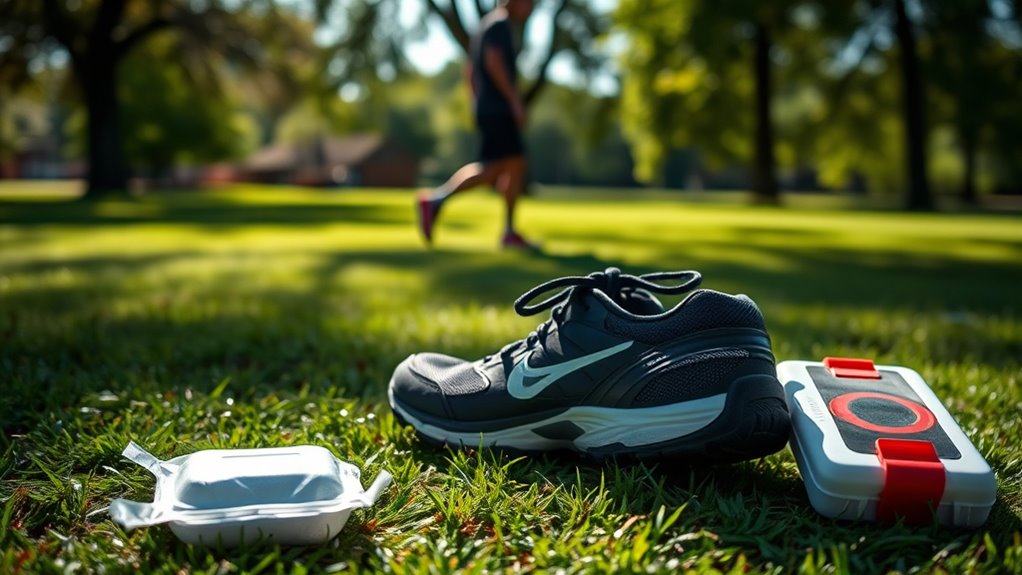Understanding sports injuries like sprains and strains is essential for any athlete. A sprain occurs when ligaments connecting bones are stretched or torn, while a strain involves the muscles or tendons. Early signs include pain and swelling. To recover, use the RICE method—rest, ice, compression, and elevation. Injury prevention starts with proper warm-ups and strength training. If you’re enthusiastic to learn more about how to protect yourself from these injuries, there are effective strategies to explore.
Key Takeaways
- Sprains involve ligament injuries, while strains affect muscles or tendons; recognizing the difference is crucial for effective treatment.
- Immediate care for both sprains and strains includes the RICE method: Rest, Ice, Compression, and Elevation.
- Preventing injuries requires proper warm-ups, stretching, strength training, and awareness of body signals during physical activities.
- Listening to your body and taking breaks can help avoid pushing through pain, reducing the risk of severe injuries.
- Recovery should be patient and guided by medical professionals, focusing on tailored exercises to restore strength without rushing back to activities.

Whether you’re a weekend warrior or a seasoned athlete, understanding sports injuries is essential for staying in the game. Sprains and strains are among the most common injuries you might encounter, and knowing the differences between them can help you tackle recovery more effectively. A sprain occurs when you stretch or tear a ligament, the tissue that connects bones at a joint, while a strain involves muscles or tendons, which connect muscles to bones. Recognizing the signs of these injuries early can make a significant difference in your muscle recovery and overall performance.
Understanding the differences between sprains and strains is crucial for effective recovery and optimal performance in sports.
When you experience a sprain or strain, you might feel pain, swelling, or instability in the affected area. Immediate care is paramount. Following the RICE method—Rest, Ice, Compression, and Elevation—can aid in reducing pain and swelling. Resting the injured area allows your body to begin the healing process. Applying ice for about 20 minutes every hour can help minimize swelling. Compression with a bandage or wrap provides support, and elevating the injury above heart level can further reduce swelling.
Incorporating injury prevention strategies into your routine is essential for reducing your risk of sprains and strains. Start by warming up and cooling down properly during your workouts. Stretching before and after exercise prepares your muscles and joints, enhancing flexibility and range of motion. Strength training is also key; building muscle strength around joints can provide additional support, decreasing the likelihood of injury. Additionally, practicing Leave No Trace principles while engaging in outdoor sports can help preserve the environment and ensure safe play.
Don’t overlook the importance of listening to your body. If you feel fatigue or discomfort, take a break. Pushing through the pain can lead to more severe injuries, prolonging your muscle recovery time. Staying hydrated and maintaining a balanced diet will support your overall health and enhance your performance on the field.
Once you’ve sustained an injury, patience is essential. While it can be frustrating to be sidelined, rushing back into action can lead to reinjury. Set realistic recovery goals and consult a medical professional or physical therapist, if needed. They can guide you through tailored exercises that promote healing and restore strength.
Frequently Asked Questions
What Are the Best Preventative Measures for Sprains and Strains?
To prevent sprains and strains, you should always warm up before any physical activity. Proper stretching helps increase flexibility and prepares your muscles for action. Incorporate dynamic stretches that target the muscles you’ll use during your sport. Additionally, strengthen your muscles through regular exercise and pay attention to your body’s signals. If something feels off, don’t push it. Being mindful and proactive can markedly reduce your risk of injury.
How Long Does Recovery Typically Take for These Injuries?
Recovery timelines for sprains and strains can vary widely, but you can generally expect a rehabilitation duration of a few days to several weeks. Minor sprains may heal within a week, while more severe injuries might take up to six weeks or longer. It’s vital to follow your doctor’s advice and engage in proper rehabilitation exercises to guarantee a full recovery and avoid setbacks, so you can get back to your activities safely.
Can Sprains and Strains Lead to Long-Term Complications?
Yes, sprains and strains can lead to long-term complications, like a shadow lurking behind your every move. Chronic pain may haunt you if the injury isn’t fully healed, turning simple tasks into formidable challenges. Plus, if you rush back too soon, the reinjury risk spikes, making you vulnerable to further setbacks. So, listen to your body, give it the time it needs, and you’ll dance through recovery without those shadows trailing you.
Are Certain Sports More Prone to These Types of Injuries?
Yes, certain sports are definitely more prone to sprains and strains due to sport-specific risks. For instance, contact sports like football and rugby often see higher injury prevalence because of the physical demands and impacts involved. Similarly, sports like basketball and soccer can lead to ankle sprains from rapid changes in direction. Being aware of these risks can help you take preventative measures and reduce your chances of getting injured while playing.
What Role Does Nutrition Play in Injury Recovery?
Nutrition plays a vital role in your injury recovery. Incorporating dietary supplements, like protein and vitamins, can help speed up healing and tissue repair. You should also focus on hydration strategies, as staying well-hydrated aids in circulation and nutrient transport. Eating a balanced diet rich in whole foods will provide the essential nutrients your body needs. Prioritizing these aspects will enhance your recovery process and get you back to your sport faster.
Conclusion
Just like a tree bends but doesn’t break in a storm, your body can withstand the challenges of sports injuries. By understanding the science behind sprains and strains, you’re not just weathering the tempest; you’re learning to grow stronger through it. Embrace the journey of recovery, nurture your body, and soon, you’ll stand tall once more, ready to dance with the winds of competition. Remember, every setback is just a chance for a stronger comeback.









